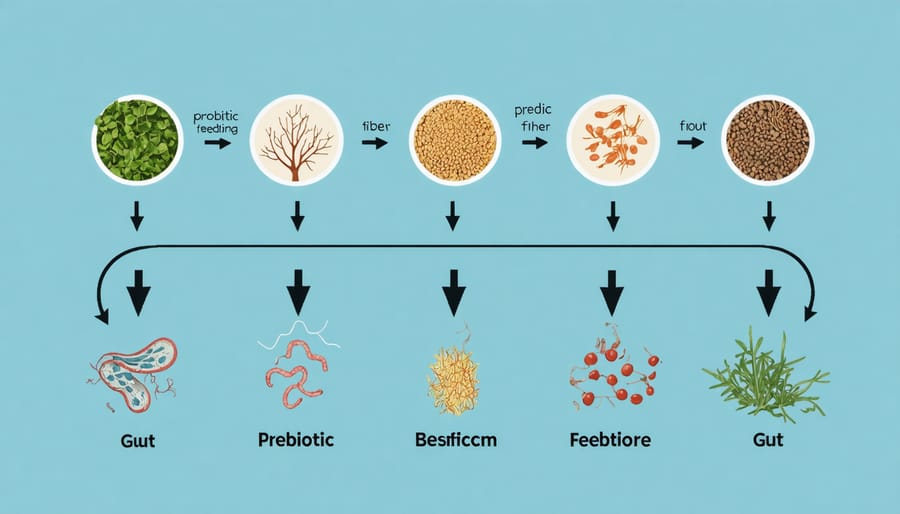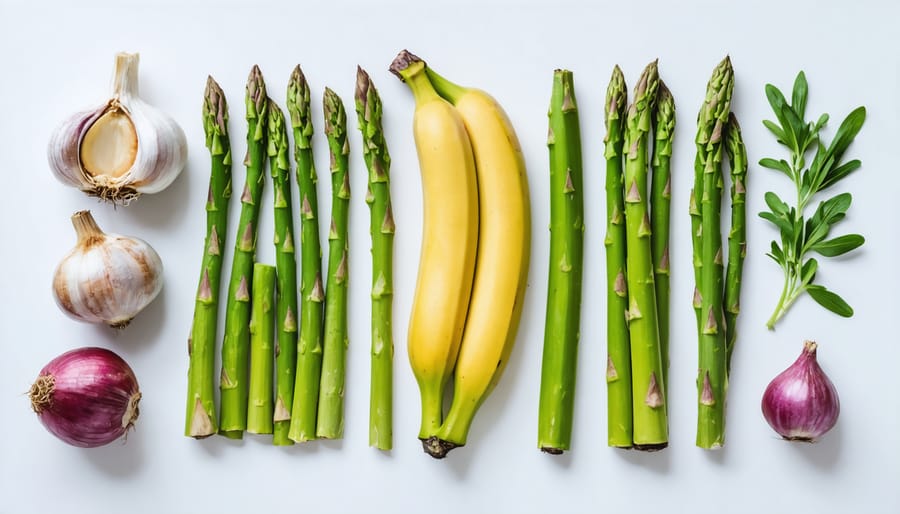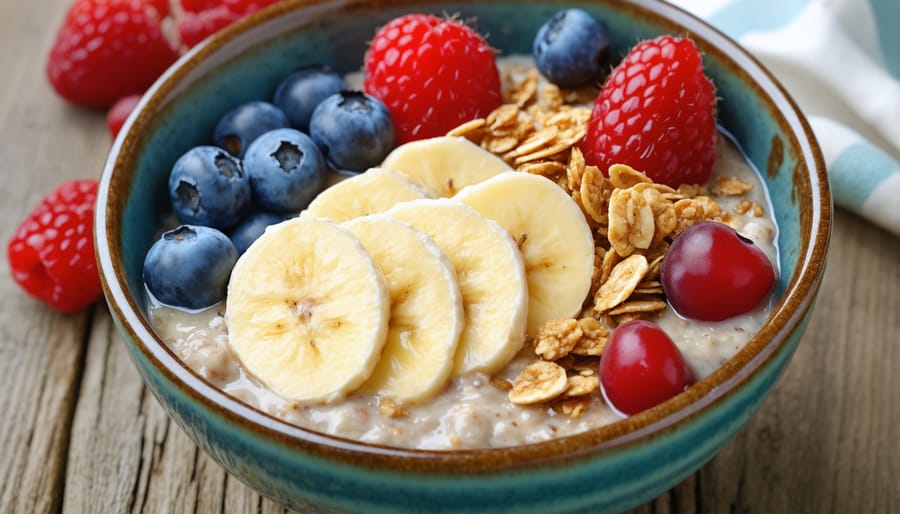
Transform your gut health with the overlooked superheroes of nutrition: plant-based prebiotic fibers. These powerful compounds feed the beneficial bacteria in your digestive system, creating a thriving microbiome that supports everything from immune function to mental clarity. Unlike their more famous cousins, probiotics, prebiotic fibers work behind the scenes as the essential fuel that keeps your gut ecosystem flourishing.
Think of prebiotics as your internal gardeners, cultivating a diverse and healthy community of beneficial bacteria that transforms your digestive system into a powerhouse of wellness. From the inulin in dandelion roots to the resistant starch in cooled rice, nature has packed these remarkable compounds into everyday foods you probably already enjoy.
Whether you’re looking to boost your energy levels, improve your digestion, or support your overall health, understanding and incorporating plant-based prebiotic fibers into your daily routine might just be the missing piece in your wellness puzzle. Let’s explore how these remarkable dietary elements can revolutionize your approach to nutrition and well-being.
Why Your Gut Craves Plant-Based Prebiotics
The Magic Behind Prebiotic Fiber
Think of prebiotic fiber as a special kind of food – not for you, but for the beneficial bacteria living in your gut! When you eat foods rich in prebiotic fiber, it travels through your digestive system unchanged until it reaches your large intestine. There, it becomes a feast for your friendly gut bacteria, who break it down through fermentation.
This process is like having a garden in your gut where you feed and nurture beneficial microorganisms. As these good bacteria consume the prebiotic fiber, they multiply and produce beneficial compounds called short-chain fatty acids. These compounds help maintain a healthy gut environment, strengthen your intestinal barrier, and support your overall digestive health.
Just as you’d feed a garden to help it flourish, feeding your gut bacteria with prebiotic fiber helps create a thriving ecosystem inside you. It’s a beautiful example of the symbiotic relationship between the food we eat and our body’s natural processes.

Benefits Beyond Digestion
The magic of plant-based prebiotic fiber extends far beyond your digestive system. While maintaining healthy gut flora is fantastic, these dietary powerhouses pack even more benefits into their tiny packages. Research shows that prebiotics play a crucial role in supporting your immune system, helping your body defend against unwanted visitors. They’re like your personal wellness warriors!
What’s particularly fascinating is the connection between gut health and mood. When you incorporate prebiotics into your mindful eating habits, you’re not just nourishing your body – you’re feeding your happiness too! The gut-brain axis is real, and prebiotics help produce feel-good chemicals that can boost your mood and reduce stress levels.
Additionally, these fibers help maintain healthy blood sugar levels, support calcium absorption, and may even aid in maintaining a healthy weight. It’s amazing how something so simple can have such a profound impact on our overall wellbeing!

Delicious Sources of Plant-Based Prebiotics
Kitchen Staples You Already Love
Good news for your gut health journey – some of your favorite kitchen staples are actually prebiotic powerhouses! While exploring plant-based diet benefits, I discovered that many everyday ingredients I already loved were secretly supporting my digestive health.
Take onions and garlic, for instance. These flavor-packed essentials don’t just make everything taste better – they’re loaded with prebiotic fiber. I always keep them on hand for cooking, and now I feel even better about using them generously in my recipes! Bananas, especially slightly underripe ones, are another fantastic source. They’re perfect for breakfast smoothies or as an afternoon snack.
Looking in your pantry, you might spot more prebiotic heroes: oats, wheat, and barley all contain this beneficial fiber. Even that apple you pack for lunch is working double-duty as a prebiotic source. And if you’re a fan of jerusalem artichokes (also known as sunchokes), asparagus, or leeks, you’re already incorporating some of the best prebiotic foods into your diet.
The beauty of these foods is that they’re not exotic or hard to find – they’re probably already part of your weekly shopping list. By being mindful about including these familiar ingredients in your meals, you’re naturally supporting your gut health without making dramatic changes to your diet.
Superstar Prebiotic Foods to Try
Ready to discover some superstar prebiotic foods that might not be on your regular grocery list? Let me introduce you to some amazing options that I wish I’d known about sooner!
Jerusalem artichokes, also known as sunchokes, are true prebiotic powerhouses. These knobby little root vegetables have a slightly sweet, nutty flavor that’s divine when roasted. I love adding them to root vegetable medleys or blending them into creamy soups. Fair warning though – start with small portions as your gut adjusts to their fiber-rich goodness!
Chicory root is another prebiotic superstar that might surprise you. You’ve probably encountered it without realizing – it’s often used in coffee alternatives! The root can be roasted and ground, adding a delicious coffee-like flavor to beverages while delivering impressive prebiotic benefits.
Don’t overlook tiger nuts (which aren’t actually nuts at all)! These small tubers have a lovely sweet taste and can be enjoyed as snacks, milk alternatives, or flour. My personal favorite is tiger nut flour in breakfast muffins – such a nutritious way to start the day!
Dandelion greens might be growing in your backyard, but they’re far from just weeds. These bitter greens are packed with prebiotics and add a sophisticated touch to salads or sautéed dishes. Try them with a drizzle of olive oil and a pinch of sea salt – delicious!
Easy Ways to Add More Prebiotic Foods to Your Day
Breakfast Boost Ideas
Start your day with a gut-healthy boost by incorporating these delicious prebiotic-rich breakfast ideas into your morning routine! As a recovering breakfast-skipper turned morning meal enthusiast, I’ve discovered that getting my prebiotics in early sets a positive tone for the whole day.
Try topping your overnight oats with sliced bananas and a sprinkle of raw dandelion root. The natural sweetness of bananas pairs perfectly with the earthy notes, while both ingredients work together to feed those beneficial gut bacteria. Another favorite combo is a warming bowl of steel-cut oats with chopped apple, Jerusalem artichoke (also known as sunchokes), and a drizzle of maple syrup.
For something quick and satisfying, blend up a smoothie with green banana (yes, slightly unripe!), berries, and a handful of raw asparagus – trust me, you won’t even taste it! Add some plant-based yogurt for extra creaminess and probiotic benefits.
If you prefer savory breakfasts, try a nourishing grain bowl with quinoa, sautéed leeks, and garlic. Top it with a soft-boiled egg and fresh herbs for a protein boost. For busy mornings, keep some homemade granola on hand, loaded with nuts, seeds, and chicory root – it’s perfect for sprinkling over your favorite plant-based yogurt or enjoying with unsweetened almond milk.
Remember, variety is key when it comes to prebiotics, so mix and match these ideas throughout your week!

Snacks and Sides That Support Gut Health
Looking for ways to sneak more prebiotic fiber into your day? I’ve discovered some delicious snacks and sides that not only satisfy cravings but also support gut health. These simple additions can easily fit into your meal prep strategies for the week ahead.
Start your day with a banana and a handful of raw almonds – both excellent sources of prebiotics. For a mid-morning boost, try sliced apple wedges dipped in Jerusalem artichoke hummus, which doubles up on prebiotic power. One of my favorite afternoon pick-me-ups is a small bowl of overnight oats topped with fresh berries and a sprinkle of ground flaxseeds.
When it comes to sides, roasted garlic asparagus makes a delicious addition to any main dish. I love preparing a big batch of cooling potato salad made with cooked-and-cooled potatoes (hello, resistant starch!) and dressed with a tangy yogurt-based sauce. For something different, try sautéed dandelion greens with a touch of olive oil and lemon – they’re surprisingly delicious and packed with prebiotic benefits.
Keep convenient options on hand like raw jicama sticks, which make perfect crunchy snacks, or blend up a smoothie with green banana and kiwi for a refreshing prebiotic boost. Remember, consistency is key – incorporating these foods regularly will help support your gut’s beneficial bacteria.
Getting Started: Your Gentle Path to Better Gut Health
Starting your prebiotic journey doesn’t have to feel overwhelming – in fact, the gentler you begin, the better your body will adjust. Think of it as training your gut: you wouldn’t run a marathon without proper preparation, right? The same goes for introducing prebiotic fiber into your diet.
Begin by adding small amounts of prebiotic-rich foods to your daily meals. Try slicing half a banana into your morning oatmeal or tossing a handful of dandelion greens into your lunchtime salad. As your body adapts, gradually increase portions and variety over several weeks.
You might experience some initial changes – a bit of extra gas or slight bloating is completely normal as your gut bacteria adjust to their new fuel source. This is actually a good sign that your beneficial bacteria are thriving! To minimize any discomfort, stay well-hydrated and listen to your body’s signals.
Here’s a simple weekly plan to get started:
– Week 1: Add one small serving of prebiotic foods daily
– Week 2: Increase to two small servings
– Week 3: Experiment with different prebiotic sources
– Week 4: Work up to 3-4 servings spread throughout the day
Remember, consistency matters more than quantity. Pay attention to how your body responds and adjust accordingly. Many people notice improved digestion, more energy, and better mood within a few weeks of consistent prebiotic intake. The key is to be patient with yourself and celebrate small progress along the way.
Adding prebiotic fiber to your daily routine doesn’t have to be complicated or overwhelming. As we’ve explored, these powerful plant-based compounds are essential for maintaining a healthy gut microbiome and supporting overall wellness. Start small by incorporating one or two prebiotic-rich foods into your meals each day – perhaps adding banana to your morning smoothie or enjoying a serving of crispy Jerusalem artichokes with dinner. Remember, every small step counts toward better digestive health. The best part? Most prebiotic foods are delicious and versatile, making them easy to include in your favorite recipes. Listen to your body as you increase your fiber intake, and adjust portions gradually. Your gut bacteria will thank you, and you’ll likely notice improvements in your digestion, energy levels, and overall well-being. Ready to get started? Your journey to better gut health begins with your next meal!



